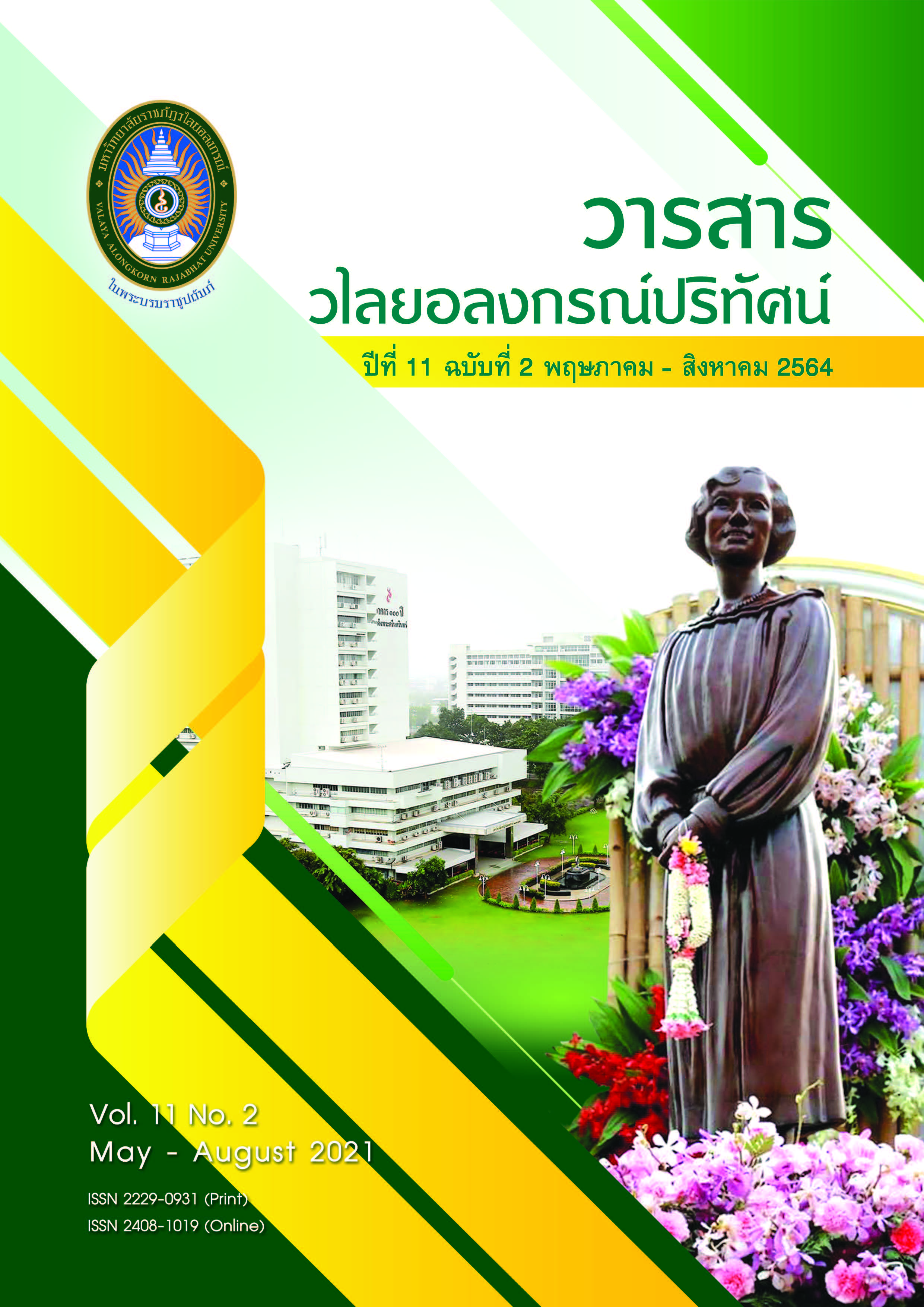การวิเคราะห์วาทกรรมเชิงวิพากษ์ของมีมกับการเสียดสีในภาษาอังกฤษและภาษาไทย
คำสำคัญ:
มีม, การเสียดสี, การวิเคราะห์วาทกรรมเชิงวิพากษ์บทคัดย่อ
งานวิจัยนี้มีวัตถุประสงค์เพื่อ 1) ศึกษารูปแบบของมีมที่สื่อความหมายเสียดสี ในภาษาอังกฤษและภาษาไทย 2) ศึกษาหัวข้อและความหมายของมีมที่สื่ออารมณ์เสียดสี ในภาษาอังกฤษและภาษาไทย และ 3) เปรียบเทียบการใช้มีมเพื่อสื่อความหมายเสียดสี ในภาษาอังกฤษและภาษาไทย กลุ่มตัวอย่างแบบเจาะจงเป็นมีมภาษาอังกฤษและภาษาไทย ที่สื่ออารมณ์เสียดสีทั้งที่มีเฉพาะข้อความหรือรูปภาพและข้อความประกอบรูปภาพจาก Facebook Page ชื่อ Sarcasmlol และจาก Facebook Page ชื่อ MEME Thailand ตั้งแต่เดือนมกราคม 2562 – มิถุนายน 2563 ซึ่งมีค่าความสอดคล้องในการหาคุณภาพเครื่องมือ (IOC) เท่ากับ 0.7 การวิเคราะห์รูปแบบของมีมใช้เกณฑ์ด้านความหมายของฮิอาอิและชิมาดะ ส่วนการศึกษาหัวข้อและความหมายของมีมใช้หลักการวิเคราะห์วาทกรรมเชิงวิพากษ์
ผลการวิจัยพบว่ามีมภาษาอังกฤษที่สื่ออารมณ์เสียดสีมี 8 รูปแบบ ส่วนมีมภาษาไทยมี 4 รูปแบบ สำหรับหัวข้อและความหมายของมีมภาษาอังกฤษมีการอ้างถึง 15 หัวข้อ ส่วนภาษาไทย มีการอ้างถึง 13 หัวข้อ เมื่อเปรียบเทียบมีมภาษาอังกฤษและภาษาไทยพบว่ามีแนวโน้มที่จะมี การถ่ายทอดทางวัฒนธรรมทางอินเตอร์เน็ต
เอกสารอ้างอิง
กาญจนา เจริญเกียรติบวร. (2548). การวิเคราะห์วาทกรรมเรื่องตลกภาษาไทย. วิทยานิพนธ์อักษรศาสตรดุษฎีบัณฑิต สาขาภาษาศาสตร์ คณะอักษรศาสตร์ จุฬาลงกรณ์มหาวิทยาลัย.
Ardelia, I. & Zubaidah, N. (2018). A discourse analysis of memes. Getsempena English Education Journal (GEEJ). 5(2): 58-64.
Castells, M., &Haraway, D. (2007). Why cyberculture? In D. Bell (ed.). Cyberculture Theorists. New York: Routledge.
Critchley, S. (2002). On Humour. London: Routledge.
Dawkins, R. (2006). The Selfish Gene (original work published 1976 ed.). New York: Oxford University Press.
Eriyanto, P. (2001). Analisis wacana: Pengantar analisis teks media. Yogyakarta: LKiS.
Fairclough, N. (1992). Discourse and Social Change (Vol. 73). Cambridge: Polity press.
Fulcher, R. (2010). Critical Discourse Analysis. London and New York. Longman.
Hiai, S. & Shimada, K. (2016). Sarcasm extraction method based on patterns of evaluation expressions. Proc International Congress on Advanced Applied Informatics. 5th IIAI-AAI: 31-36.
Kariko, A. A. (2013). Analysis on Internet Memes using Semiotics. [Online], Available: http://english.binus.ac.id/2013/06/24/analysis-on-internet-memes-using-semiotics. (2020, 7 June).
Jaroenkitboworn, K. (2020). Funny English in the digital world. LEARN Journal: Language Education and Acquisition Research Network Journal. 13(1): 39-61.
Liu, B. (2012). Sentiment analysis and opinion mining. Synth Lect Hum Lang Technol. 5(1):1–167.
Locke, T. (2004). Critical Discourse Analysis. London: Cromwell Press.
McGregor, S. L. (2010). Critical Discourse Analysis: A Primer. Halifax: Mount Saint Vincent University.
Milner, R. M. (2016). The world made meme: Public conversations and participatory media. Cambridge, MA: MIT Press.
Nissenbaum, A. & Shifman, L. (2018). Meme templates as expressive repertoires in a globalizing world: A cross-linguistic study. Journal of Computer-Mediated Communication. 23(5): 294-310.
Octavita, A. I. & Zaimar, Y. S. (2018). Semiotic analysis of satire meme connecting women’s identity in Brillio Net. Journal of English Language Teaching. 3(1): 38-45.
Ramanathan, R. & Hoon, T. B. (2015). Application of critical discourse analysis in media discourse studies. 3L: The Southeast Asian Journal of English Language Studies. 21(2): 57-68.
Rahimi, E. & Sharrififar, M. (2015). Critical Discourse Analysis and Its Implication in English Language Teaching: A case study of political text. Theory and Practice in Language studies. 5(3): 504-511.
Rambe, P. (2012). Critical discourse analysis of collaborative engagement in Facebook postings. Australasian Journal of Educational Technology. 28(2): 295-314.
Rogers, R., et al. (2005). Critical Discourse Analysis in Education: A Review of the Literature. Washington: Sage Publications.
Shifman, L. (2013). Memes in digital culture. Cambridge, MA: MIT Press.
Sindhu, C. S. & Vadivu, G. (2018). A Comprehensive study on sarcasm detection techniques in sentiment analysis. International Journal of Pure and Applied Mathematics. 18(22): 433-442.
Triyono, S. & Putra, R. A. (2016). The Diversity of Internet Memes Interpretations: A Discourse Analysis of Incongruity of Popular Memes Made by Indonesian Netizen. Journal of Linguistics and Education. 6(2): 49-61.
Van Dijk, T. A. (2003). Critical discourse analysis. In D. Tannen, D. Schiffrin & H. Hamilton (Eds.), Handbook of discourse analysis. Oxford: Blackwell.
Wodak, R. & Meyer, M. (2009). Critical discourse studies: A sociocognitive approach. In R. Wodak & M. Meyer. (2nd ed). Methods of critical discourse analysis. Thousand Oaks: Sage.
ดาวน์โหลด
เผยแพร่แล้ว
รูปแบบการอ้างอิง
ฉบับ
ประเภทบทความ
สัญญาอนุญาต
ข้อความที่ปรากฏในบทความแต่ละเรื่องในวารสารวไลยอลงกรณ์ปริทัศน์ เป็นความคิดเห็นของผู้นิพนธ์แต่ละท่าน มิใช่เป็นทัศนะและมิใช่ความรับผิดชอบของกองบรรณาธิการจัดทำวารสาร และ
มหาวิทยาลัยราชภัฏวไลยอลงกรณ์ ในพระบรมราชูปถัมภ์


